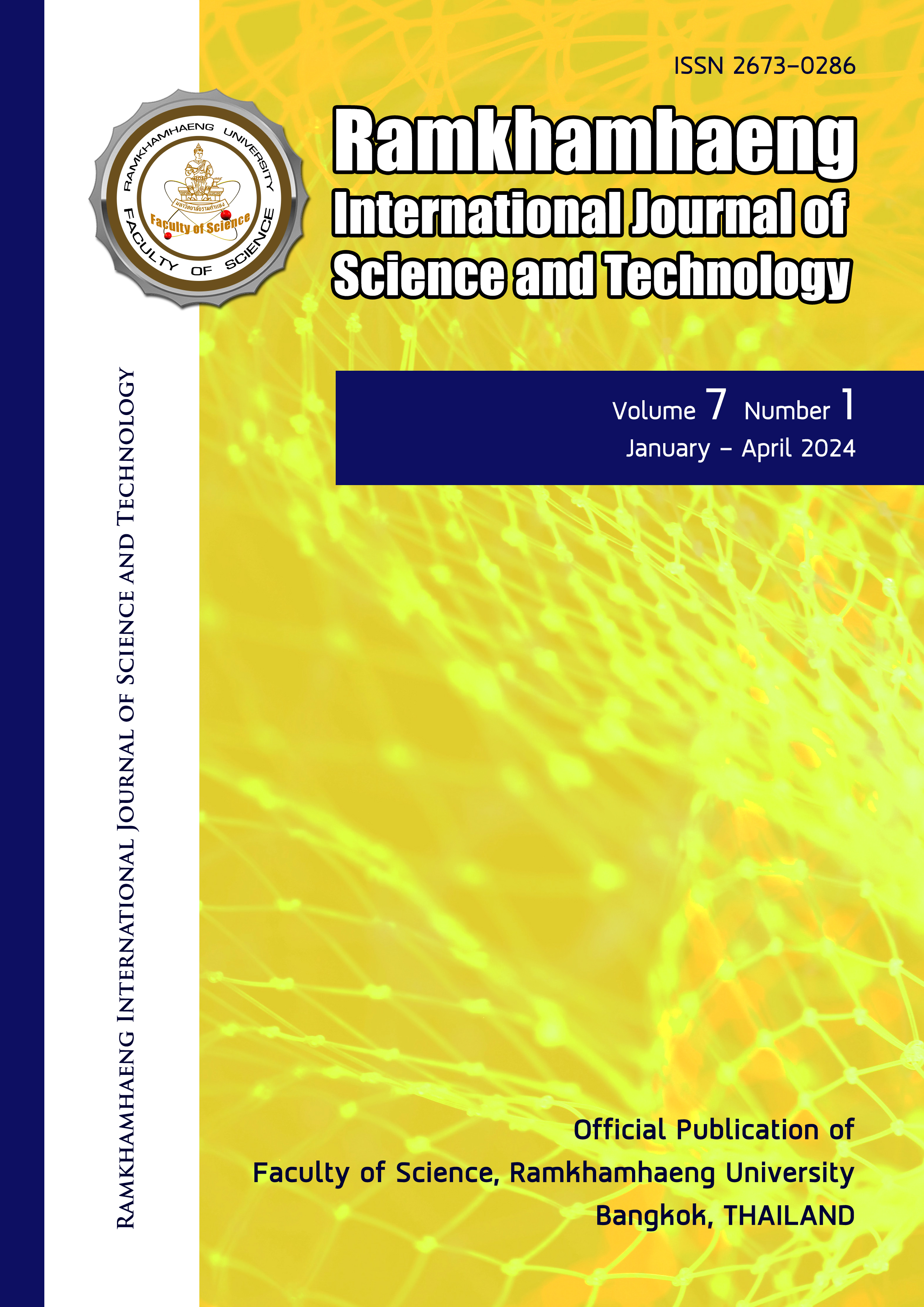Bioplastic packaging containing Ceasalpinia sappan heartwood extract to inhibit Escherichia coli causing spoilage of pork jerky
Keywords:
minimal inhibitory concentration, minimal bactericidal concentration, disc diffusion methodAbstract
Pork jerky, a processed pork product, is susceptible to spoilage caused by contamination with Escherichia coli. Moreover, the plastic packaging used for these pork sticks contributes to environmental pollution. In response to these concerns, this project aims to develop a bio-based packaging solution by incorporating Caesalpinia sappan heartwood extract derived from a medicinal plant known for its antibacterial properties against gram-negative bacteria, specifically E. coli, which is responsible for spoilage in pork jerky. The inhibitory activity of the crude extracts from C. sappan heartwood against E. coli was evaluated using disc diffusion method. The results demonstrated that the crude extracts effectively inhibit the growth of E. coli, with a minimum inhibitory concentration of 1,875 ppm and a minimum bactericidal concentration of 7,500 ppm. Accordingly, a bioplastic formulation was developed using 7,500 ppm of C. sappan heartwood extract and then tested the physical property of the bioplastics. The tests revealed no significant differences in thickness and water absorption between the bioplastic containing the extract and the bioplastic containing 0.1% dimethyl sulfoxide. The inhibitory activity was further assessed, demonstrating that the bioplastic incorporating C. sappan heartwood extract effectively inhibits the growth of E. coli on nutrient agar. Based on these promising findings, it can be concluded that the bio-based plastic, mixed with 7,500 ppm of C. sappan heartwood extract, has the potential to serve as an effective packaging solution for pork jerky. This innovative approach not only hinders the growth of E. coli but also offers the advantage of being environmentally friendly.
References
Arikan EB, Ozsoy HD (2015) A Review: Investigation of Bioplastics. Journal of Civil Engineering and Architecture 9: 188-192.
Ekici G, Dümen E (2019) Escherichia coli and food safety. In: The universe of Escherichia coli. Ed, MS Erjavec. IntechOpen publishing, 1st ed. London, UK, pp 85-100.
Hemthanon T, Ungcharoenwiwat P (2022) Antibacterial activity, stability, and hemolytic activity of heartwood extract from Caesalpinia sappan for application on nonwoven fabric. Electronic Journal of Biotechnology 55: 9-17.
Marichelvam M, Jawaid KM, Asim M (2019) Corn and rice starch-based bio-plastics as alternative packaging materials. Fiber 7(4): 1-13.
Muangrat R, Jirarattanarangsr W, Simapisan P (2022) Response surface methodology applied to subcritical solvent extraction of brazilin compound from Caesalpinia sappan L. heartwood. Journal of Applied Research on Medicinal and Aromatic Plants 31: 100408. https://doi.org/10.1016/j. jarmap.2022.100408
Nirmal NP, Rajput MS, Prasat RG, Ahmed M (2015) Brazilin from Caesalpinia sappan heartwood and its pharmacological activities: A review. Asian Pacific Journal of Tropical Medicine 8(6): 421-430.
Office International des Epizooties (OIE) (2022) Immediate notification, African Swine Fever virus, Nepal. https://wahis.oie.int/#/report-info?reportId=54166
Peelman N, Ragaert P, De Meulenaer B, Adons, D, Peeters R, Cardon L, Van Impe F, Devlieghere F (2013) Review: application of bioplastics for food packaging. Trends in Food Science and technology 32: 128-141.
Prasteen P, Thushyanthy Y, Mikunthan T, Prabhaharan M (2018). Bio-plastics – An alternative to petroleum-based plastics. International Journal of Research Studies in Agricultural Sciences 4(1): 1-7.
Rachtanapun P (2012) Effect of relative humidity on mechanical properties of blended chitosan-methylcellulose film. 39(1): 133-137.
Saenjum C, Chaiyasut C, Kadchumsang S, Chansakaow S, Suttajit M (2010) Antioxidant activity and protective effects on DNA damage of Caesalpinia sappan L. extract. Journal of Medicinal Plants Research 4(15): 1594-1600.
Smith Ian WM, Ravishankara AR (2002) Role of hydrogen-bonded intermediates in the bimolecular reactions of the hydroxyl radical. The Journal of Physical Chemistry 106: 4798-4807.
Srinivasan R, Selvam GG, Karthik S, Mathivanan K, Baskaran R, Karthikeyan M (2012) In vitro antimicrobial activity of Caesalpinia sappan L. Asian Pacific Journal of Tropical Biomedicine 1: S136-S139.
Washiyama M, Sasakiy Y, Hosokawat T, Nagumo S (2009) Anti-inflammatory constituents of Sappan Lignum Biological and Pharmaceutical Bulletin 32(5): 941-944.
Yodsaoue O, Cheenpracha S, Karalai C, Ponglimanont C, Tewtrakul S (2009) Anti-allergic activity of principles from the roots and heartwoods of Caesalpinia sappan on antigen induced b-hexosaminidase release. Phytotherapy Research 23(7): 1028-1031.
Zaidan MRS, Noor RA, Badrul AR, Adlin A, Norazah A, Zakiah I (2005) In vitro screening of five local medicinal plants for antibacterial activity using disc diffusion method. Tropical Biomedicine 22(2): 165-170.
Downloads
Published
Issue
Section
License
Copyright (c) 2024 Ramkhamhaeng International Journal of Science and Technology

This work is licensed under a Creative Commons Attribution-NonCommercial-NoDerivatives 4.0 International License.
Copyright Notice: a copyright on any article in the published journal is retained by the Ramkhamhaeng International Journal of Science and Technology. Readers or Users grant the right to use of the Article contained in the Content in accordance with the Creative Commons CC BY-NC-ND license and the Data contained in the Content in accordance with the Creative Commons CC BY-NC-ND.



